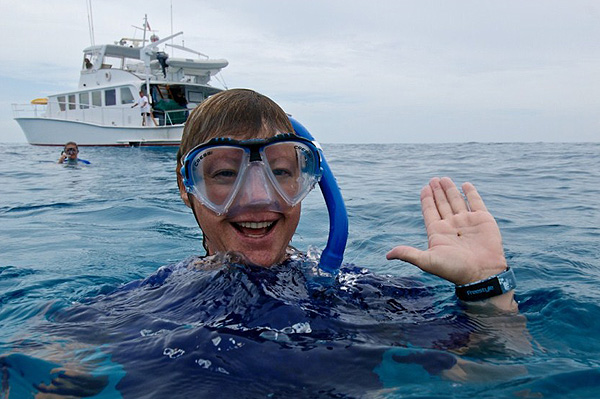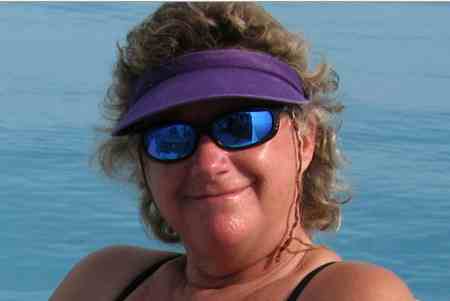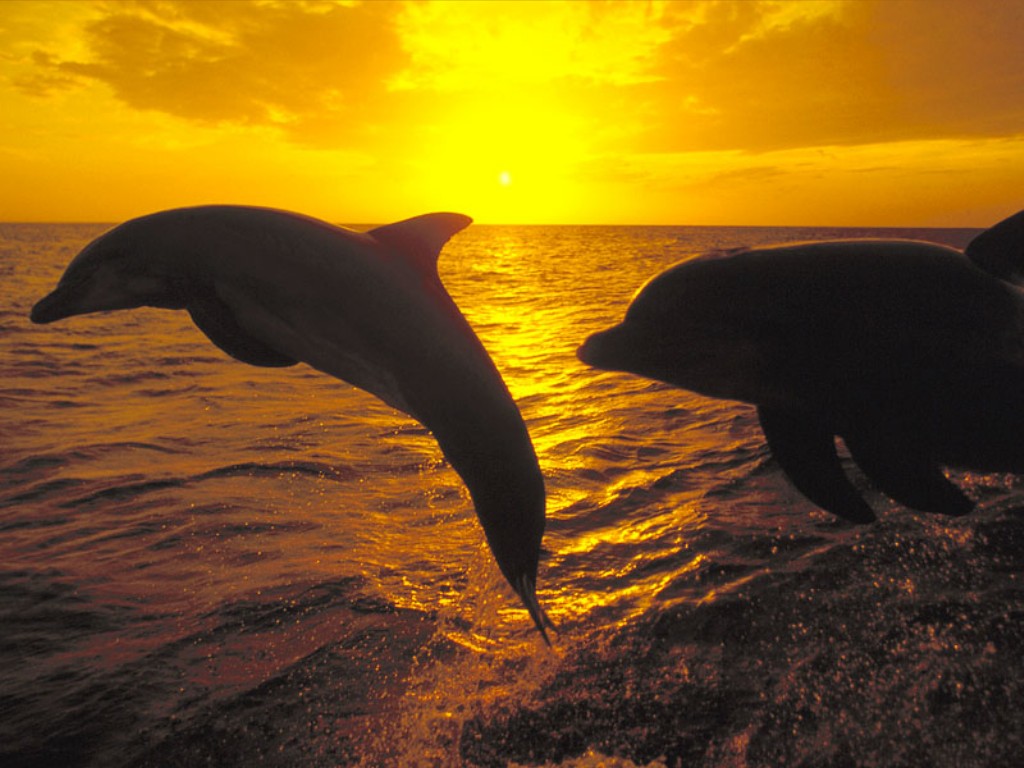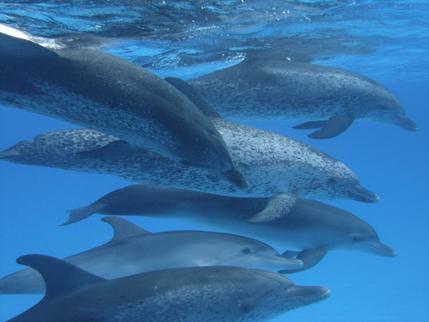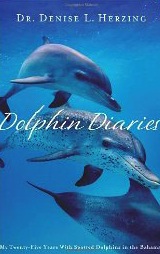Dr. Denise Herzing: ‘I was just one of those nerdy kids who used to page through the Encyclopedia Britannica, and I would always stop at the whale and dolphin pages, and I would always wonder ‘What are they doing with these big, complex minds in the water?’’Diving Deeply Into The World Of Dolphins With a Renowned Expert--And Not Just Talking About Them, But With Them
By Duncan Strauss
Host, ‘Talking Animals,’ at NPR affiliate station WMNF-FM, Tampa, Florida; online at www.talkinganimals.netDr. Denise Herzing knows a lot more about dolphins than I do. And she also knows a lot more about dolphins—no offense--than you do. Not looking to pick a fight or anything and, in fact, this position seems pretty inarguable, given that even dolphin experts feel Herzing is the world’s leading authority on dolphins, particularly Atlantic spotted dolphins.
Indeed, Dr. Herzing holds a PhD and a reputation as a pioneering researcher who has spent the better part of 27 years in Bahamian waters, studying Atlantic spotted dolphins. Her work tracking three generations of dolphin families—entitled the Wild Dolphin Project—has elicited comparisons with Jane Goodall.
Dr. Denise Herzing, Founder/Research Director at Wild Dolphin Project is featured in this documentary produced by Explore Team at the Annenberg Foundation. Glimpse into the life of a scientist who has dedicated her life to observe wild dolphins ‘in their world, on their terms’Dr. Herzing’s saga--as presented in newspaper profiles, her recent book, Dolphin Diaries: My 25 Years With Spotted Dolphins In The Bahamas, and in the January 18 interview on Talking Animals--appears driven by powerful storylines of ambition and vision, harking all the way back to her formative years in decidedly landlocked St. Cloud, Minn.
“Honestly, “ she recalled on Talking Animals, “I was just one of those nerdy kids who used to page through the Encyclopedia Britannica, and I would always stop at the whale and dolphin pages, and I would always wonder ‘What are they doing with these big, complex minds in the water?’
“We knew about primates, we knew about elephants. But here are dolphins—the equivalent, basically, big-brained social mammal in the water. And nobody was really studying them in that kind of detail. And sort of simultaneously, Jacques Cousteau came out on the TV—I was like, ‘Wow, the undersea world can really be explored.’ That set me on a path of marine biology and focusing on dolphin communication.”That path involved charging onto huge parcels of largely uncharted territory, guided unknowingly from a distance by a pre-eminent figure. As Dr. Herzing writes in Dolphin Diaries, “I wanted to study dolphins like Jane Goodall had studied chimpanzees,” noting elsewhere in the book “I knew of no road maps except the work of Jane Goodall and others who applied patience, perseverance and appropriate etiquette over time to build trust and access a nonhuman world.”
A video profile of Dr. Denise Herzing and the Wild Dolphin ProjectIn our radio conversation, Dr.Herzing elaborated on the importance of Goodall’s approach and research gambits constituing an abiding influence. “First of all, “ Herzing said, “she was in the wild. And, really, the only options in my day were to study dolphins in captivity. But Jane Goodall and Dian Fossey with gorillas and Cynthia Moss with elephants—they had all showed us that if you go plant yourself in the animals’ environment and try to be relatively benign and habituate them to your presence, so they’re not afraid of you, that you could eventually observe the details of their society.
“Not only were they women, they went out for 20 years and planted themselves where the animals manifest the qualities of their society and intelligence. Those were really my models.”In some ways, the salient phrase there may be “20 years.” The first portion of her book, some of which describes her efforts as a fledging researcher and scientist, is laced with references to her firm belief that she’d need to devote no less than 20 years to fieldwork studying the dolphins for her research to yield findings that she would feel truly carried significance.
Well, she’s been conducting that fieldwork for more than 25 years—long summers, really; the Bahamas doesn’t lend itself to year-round stints, partly because of the annual threat of hurricanes—and generated findings that would do Jane Goodall proud.
These findings paint a rich portrait of a complex species, including the dolphins’ ritualized courtship; how dramatically the lives of female dolphins, in particular, change when they enter the reproductive phase; how the moms stay with the calves for 2-3 years; the related importance of babysitting chores that are assigned to trusted members of a clan; the way important information is conveyed to calves and juveniles—vertical (mother to offspring), horizontal (juvenile to juvenile) or oblique (juvenile to calf, adult to juvenile).
From the Wild Dolphin Project, ‘Evidence of teaching in Atlantic spotted dolphins by mother dolphins foraging in the presence of their calves’On a somewhat related note, Dr. Herzing learned unmistakably over the years how Atlantic spotted dolphins feel about sex. They’re for it—in a big, big way. As she observes in Dolphin Diaries, “Dolphins love to have sex and they have sex a lot,” and she ain’t whistling Dixie, with The Wild Dolphin Project documenting that dolphins masturbate, males copulate with each other, male calves are encouraged within the initial months of their lives to copulate with their mother. And so on. As Herzing further notes in that same section of the book, “It truly is a sexual and social society.”
It’s perhaps that “social” aspect that may be partly responsible for a rather revolutionary breakthrough with these dolphins that Dr. Herzing appears on the brink of—something she’s worked toward and dreamed about over the arc of her career, extending all the way back, on some level, to when she was the nerdy kid flipping through Encyclopedia Britannica in St. Cloud, Minn: fostering real-time, two-way communication between dolphins and human.
Employing an underwater video camera with a hydrophone to record countless encounters and then correlating the sounds of a host of behaviors—and cataloging them, studying them, seeking to extrapolate from them—has amounted to what Dr. Herzing called in our interview “the main body of our work the last 20-plus years.”
Sex? Dolphins are for it, in a big way…In the Talking Animals conversation, she outlined that conducting an experiment pursuing “two-way interfaces” is not unique to her, nor new, citing various efforts over the years with primates, as well as with Alex, the African grey parrot—in much the same way that her book examines at various points the history of research in this realm, and some of the more notable figures, generously crediting her research forebears upon which she’s built the theories and experiments that have, in 2012, placed her within a dorsal fin or two from human/cetacean conversation.
She also freely acknowledges that these significant advances within The Wild Dolphin Project can be partly attributed to corresponding technological advances and the development of various types of hardware. “Now,” she explained on Talking Animals, “we have some technology that allows us to do some pretty creative things, such as real-time sound matching, and to record data on computers that tell us what animals are doing with a technological interface, for example.”
Dr. Denise HerzingChronicling their trial and efforts over the years—including a system based on one that another researcher had developed while working with captive dolphins in Orlando, involving visual versus audio cues and a big, clunky keyboard--she says they’ve traveled to a more sophisticated version of an earlier step in the journey. “We’ve gone back to the idea of an acoustic interface, so we could work real time with them, with sound, in the water. The idea is to explore whether they’d be interested in using a system of sound to request things from us, or not.”
When she heads back to the Bahamas this summer, there’s a somewhat muted expectation that resuming where they left off at the end of last summer may result in the breakthrough Dr. Herzing and her colleagues have been flirting with for years. For decades, really. We here at Talking Animals headquarters, perhaps all too predictably, remain extremely interested in any efforts that cultivates animals actually…talking.
Still, as the interview was drawing to a close, I couldn’t help wonder about the implications of this dramatic step—what does it actually mean for ahuman to communicate back and forth with a dolphin, beyond the familiar, unilateral expression of “Hey, if you jump through this hoop, I’ll give you a fish.”
She paused for a moment. Then: “For one thing it takes us past the idea of ‘we can train animals’—I mean, we can train humans, too, for that matter. But the idea of empowering another species through technology, essentially, in the case of dolphins, at least, bridges a sensory gap. For example, they’re not going to speak English words, and they don’t have hands. So how are you going to do that?
Dolphins at play: ‘In some ways, the animals are way ahead of us. They can already understand and work in another species’ system, to a certain extent.’“Maybe go into their world a little bit, try to bridge a gap, and maybe give them some tools that are mutually accessible….It opens up the idea that ‘Hey, you know, there might be some other sentient creatures on the planet’—we might learn a lot from how other species communicate, both to each other, and across species lines. Which they do with each other, by the way.
She laughed. “In some ways, the animals are way ahead of us. They can already understand and work in another species’ system, to a certain extent. So there’s precedent already. And they do it because they have to. Necessity is the mother, as they say. So I think the implications are pretty interesting.”
Me too, Dr. Herzing. Me, too.
To hear the entire interview with Dr. Denise Herzing, follow this link: www.talkinganimals.net
To donate to the Wold Dolphin Project, visit the organization’s website http://www.wilddolphinproject.org/
Dr. Denize L. Herzing’s Dolphin Diaries: My 25 Years With Spotted Dolphins In The Bahamas is available at www.amazon.com
Founder/Publisher/Editor: David McGee
Contributing Editors: Billy Altman, Laura Fissinger, Christopher Hill, Derk Richardson
Logo Design: John Mendelsohn (www.johnmendelsohn.com)
Website Design: Kieran McGee (www.kieranmcgee.com)
Staff Photographers: Audrey Harrod (Louisville, KY; www.flickr.com/audreyharrod), Alicia Zappier (New York)
E-mail: thebluegrassspecial@gmail.com
Mailing Address: David McGee, 201 W. 85 St.—5B, New York, NY 10024


